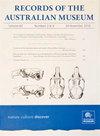澳大利亚博物馆的埃及陪葬船模型:年代和分析
IF 0.8
4区 生物学
Q4 ZOOLOGY
引用次数: 0
摘要
. 澳大利亚博物馆收藏的这艘来历不明、风格不同寻常的木船模型(AM E60381)被检查以评估其身份和年龄。对建造方法、木材、颜料和石膏的分析证明了这艘船与古埃及工艺的兼容性。确定了三种木材:黎巴嫩雪松(Cedrus libani),梧桐无花果(Ficus sycomorus)和sidr (Ziziphus spina-christi)。陪葬船模型明显与11和12王朝(公元前20世纪中期至19世纪)有关。然而,从六块不同的木头中获得的八个放射性碳年代是在公元前24世纪到公元前16世纪之间;公元前三千年晚期的六个集群。讨论了这些日期与预期时间背景之间的明显差异。风格上,类似于一个神圣的(太阳)船,模型中没有类似的表现。结合图像图案、建造方法和放射性碳年代,该模型可归因于古王国晚期和中王国早期的时期。本文章由计算机程序翻译,如有差异,请以英文原文为准。
Egyptian funerary boat model in the Australian Museum: dating and analysis
. The unprovenanced and stylistically unusual wooden boat model (AM E60381) from the Australian Museum collection is examined to assess its identity and age. The analyses of construction method, wood, pigments, and gesso demonstrate the boat’s compatibility with ancient Egyptian craftwork. Three species of wood are identified: cedar of Lebanon ( Cedrus libani ), sycomore fig ( Ficus sycomorus ), and sidr ( Ziziphus spina-christi ). Funerary boat models are distinctly associated with the 11th and 12th dynasties (mid-20th to 19th century BC). Yet eight radiocarbon dates obtained from six separate pieces of wood are between 24th and 16th century BC; six cluster at the late 3rd millennium BC. Conspicuous disparity between these dates and expected chronological context is discussed. Stylistically, resembling a divine (sun) barque, the model has no parallels among comparable representations. With combination of iconographic motifs, construction methods and radiocarbon dates, the model is attributed to the period spanning the late Old Kingdom and the early Middle Kingdom.
求助全文
通过发布文献求助,成功后即可免费获取论文全文。
去求助
来源期刊
CiteScore
0.90
自引率
0.00%
发文量
9
审稿时长
>12 weeks
期刊介绍:
Records of the Australian Museum, volume 62 was published in 2010, volume 63 in 2011. Monographic works of particular significance are published irregularly as Records of the Australian Museum, Supplements (ISSN 0812-7387).

 求助内容:
求助内容: 应助结果提醒方式:
应助结果提醒方式:


